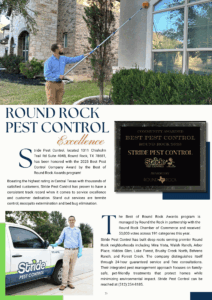
Exterminators in Round Rock, TX, typically spray both inside and outside of homes to effectively control pests. They start by evaluating the property for any pest problems. Interior areas, such as under sinks and behind appliances, are targeted first. Then, they create barriers outside to prevent pests from entering. This two-step approach helps manage infestations effectively. For a detailed look at professional pest management techniques and what to expect during treatment, visit Round Rock, Texas pest extermination.
Key Article Highlights
- Exterminators typically spray both inside and outside, depending on the type of pest and severity of the infestation.
- Indoor spraying targets areas where pests hide, such as kitchens, bathrooms, and basements.
- Outdoor treatments create barriers around the home to prevent pests from entering.
- The initial assessment helps determine specific treatment areas based on identified pest problems.
- Follow-up visits may include additional spraying or monitoring both inside and outside the property.
Understanding Pest Infestations
Understanding pest infestations is essential for homeowners. Recognizing pest behavior helps in identifying issues early. Different pests exhibit unique behaviors. For example, rodents may leave droppings, while termites create mud tubes. Homeowners must look for infestation signs to act quickly. These signs can include unusual sounds, damage to property, or visible pests. Monitoring these indicators can prevent larger problems. A small issue can quickly escalate if not addressed. Knowledge of common pests in the area also aids in understanding. Each pest has specific needs and habits. By learning about these aspects, homeowners can make informed decisions. This understanding lays the foundation for effective pest management strategies and can save time and money in the long run. Implementing routine inspections as part of a pest control strategy can significantly enhance early detection and intervention. Additionally, using integrated pest management techniques can provide long-term solutions by addressing underlying issues and preventing future infestations. Regular monitoring is crucial as it allows homeowners to identify liquid soil treatments needed to eliminate potential termite colonies before they become a significant threat.
Factors Influencing Treatment Methods
Several factors influence the choice of treatment methods for pest infestations. One major factor is treatment effectiveness. Exterminators assess which methods will yield the best results based on the specific pest involved. Different pests require different approaches. Another important factor is pest behavior. Understanding how pests live and reproduce helps exterminators decide the best time and place to apply treatments. For example, some pests may be more active at night, while others hide during the day. Additionally, the severity of the infestation can dictate whether indoor or outdoor sprays are needed. For instance, bed bug control includes inspection, heat treatment, chemical application, and mattress encasement to kill adults, nymphs, and eggs. Effective strategies for flea, tick, and chigger control involve using insect growth regulators along with broadcast sprays and spot treatments. Finally, environmental concerns and safety regulations may also affect the choice of treatment, ensuring that methods used are safe for people and pets. Effective strategies for rodent control include exclusion repairs, bait stations, and trapping to eliminate activity.
Common Indoor Pest Control Techniques

Indoor pest control uses various techniques to manage unwanted pests. Common methods include chemical treatments, baiting systems, and traps. Each technique has its own purpose and effectiveness in different situations. Additionally, effective strategies for mosquito control often involve barrier sprays and standing water management to reduce populations indoors. For example, the use of residual sprays can provide long-lasting protection against pests inside the home.
Chemical Treatments Overview
While many homeowners seek effective ways to eliminate pests, chemical treatments remain a common method for pest control. These treatments provide rapid results and can effectively target various indoor pests. However, it is vital to prioritize chemical safety during application.
Common chemical treatments include:
- Insecticides: Kill pests on contact or through ingestion.
- Fumigants: Create a gas that permeates the area to eliminate pests.
- Boric acid: A slower acting treatment that disrupts pests’ digestive systems.
- Residual sprays: Leave a lasting barrier to deter future infestations.
Understanding treatment effectiveness is important for long-term pest management. Proper application and safety measures guarantee a balanced approach to pest control. Homeowners should be well-informed to make effective choices.
Baiting Systems Explained
Baiting systems are an effective technique for controlling common indoor pests. These systems use bait stations filled with effective lures to attract unwanted insects and rodents. The bait often contains food substances combined with a slow-acting poison. When pests consume the bait, they carry it back to their nests, where it can eliminate more pests over time. Baiting techniques are especially useful for targeting specific pests, such as ants and cockroaches. They can be placed in areas where chemical sprays are not suitable. This method minimizes exposure to humans and pets while maximizing pest control. Overall, baiting systems provide a strategic approach to managing indoor pest problems effectively and safely.
Traps and Monitoring Methods
Traps and monitoring methods are commonly used for pest control in homes. These techniques help assess pest populations and improve trap effectiveness. Various traps and systems can be applied, including:
- Sticky traps that catch insects
- Snap traps for rodents
- Live traps for humane pest removal
- Monitoring systems that track pest activity
Homeowners can use these tools to detect infestations early. Monitoring systems provide data on pest presence, helping to target control efforts more effectively. By combining traps with monitoring, individuals can create a thorough approach to pest management. This strategy not only enhances trap effectiveness but also prevents larger infestations from occurring in the future. Understanding these methods is key to maintaining a pest-free environment.
Outdoor Pest Control Strategies

When dealing with outdoor pests, effective strategies can make a significant difference in maintaining a pest-free environment. One common approach is the use of natural repellents. These products can deter pests without harming the surrounding ecosystem. Homeowners can consider substances like neem oil or garlic spray to protect their gardens. Another important strategy is landscape management. This involves keeping the yard tidy by removing debris and overgrown plants, which can attract pests. Proper landscaping can also create barriers, such as placing gravel or wood chips around plants. By combining natural repellents with thoughtful landscape management, homeowners can effectively reduce pest populations and enjoy a more pleasant outdoor space.
Integrated Pest Management Approaches
Integrated Pest Management (IPM) approaches offer an extensive way to handle pest issues while minimizing risks to people and the environment. These methods focus on pest prevention strategies and sustainable pest solutions. IPM combines various techniques for effective pest control without harming the ecosystem.
Integrated Pest Management (IPM) emphasizes sustainable pest control methods that protect both people and the environment.
Key components of IPM include:
- Monitoring pest populations to identify problems early
- Using natural predators to control pest numbers
- Implementing sanitation measures to reduce pest attractants
- Applying targeted treatments only when necessary
What to Expect During a Pest Control Visit
During a pest control visit, the technician will first conduct an initial assessment of the property. This helps them identify problem areas that need treatment. After the assessment, they will apply the necessary treatments in the affected areas.
Initial Assessment Process
Although the initial assessment process may vary slightly among exterminators, it generally follows a similar pattern. The exterminator begins with an initial evaluation to understand the pest problem. This includes an inspection process that focuses on key areas of the property.
During this assessment, the exterminator will typically:
- Inspect the exterior of the building for entry points
- Check common hiding spots inside, like basements and attics
- Look for signs of pest activity, such as droppings or nests
- Discuss findings with the homeowner and recommend solutions
This structured approach helps the exterminator gather essential information. It guarantees that the following treatment is effective and tailored to the specific pest issue at hand.
Treatment Application Areas
A pest control visit typically involves several key treatment application areas. Exterminators often begin with interior spraying. This process targets areas inside the home where pests may hide, such as under sinks, behind appliances, and in corners. The goal is to eliminate existing pests and prevent future infestations.
Next, the focus shifts to creating exterior barriers. Exterminators apply treatments around the perimeter of the home. This method helps block pests from entering and establishes a protective barrier. They may treat doorways, windows, and other entry points.
Frequently Asked Questions
How Often Should I Schedule Pest Control Services?
Pest control frequency depends on the type of pest and the environment. Regular seasonal treatments help prevent infestations. Homeowners should consider scheduling services every few months to maintain a pest-free living space effectively.
Are the Chemicals Used Safe for Pets?
Like a cautious parent, many wonder about the safety of chemicals used in pest control. Pet safety is vital; professionals often select pet-friendly options to minimize chemical exposure, ensuring a secure environment for beloved animals.
What Should I Do Before the Exterminator Arrives?
Before the exterminator arrives, a preparation checklist is essential. Homeowners should remove pets, clear clutter, and vacuum floors. Following these pest control tips helps guarantee a successful treatment and a safe environment for all.
How Long Does Pest Control Treatment Last?
Pest control treatment duration varies. Factors affecting pest longevity include pest type, treatment method, and environmental conditions. Typically, treatment effectiveness lasts from weeks to several months, depending on these influences and proper follow-up care.
Can I Stay Home During the Pest Control Process?
Could staying home during pest control be safe? Many wonder about this. Pest control safety often advises leaving, as treatment effectiveness may diminish in occupied spaces. Ultimately, it depends on the specific treatment used.
Call today if you are in need of a pest exterminator in Round Rock, TX!
(512) 254-8185
DO EXTERMINATORS SPRAY INSIDE OR OUTSIDE IN ROUND ROCK, TX PDF


